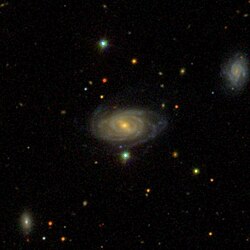| NGC 624 | |
|---|---|
 SDSS image of NGC 624 | |
| Observation data (J2000 epoch) | |
| Constellation | Cetus |
| Right ascension | 01h 35m 51.084s [1] |
| Declination | −10° 00′ 10.72″ [1] |
| Redshift | 0.019789 [2] |
| Heliocentric radial velocity | 5873.9 km/s [2] |
| Distance | 273.8 Mly (83.95 Mpc) [3] |
| Apparent magnitude (B) | 14.2 [2] |
| Characteristics | |
| Type | (R')SB(r)b pec [4] |
| Other designations | |
| MCG -02-05-010, PGC 5932 [2] | |
NGC 624 is a barred spiral galaxy in the constellation of Cetus, which is about 264 million light years from the Milky Way. It was discovered on November 28, 1785, by the German-British astronomer William Herschel. [5] [6] [7]